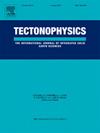Mantle influence on crustal discontinuity revealed by He isotopes and resistivity in the East African Rift System
IF 2.6
3区 地球科学
Q2 GEOCHEMISTRY & GEOPHYSICS
引用次数: 0
Abstract
As one of the most renowned continental rifts on Earth, the East African Rift System (EARS) is characterized by intense rifting and active volcanic activity, creating a favorable geological setting for the development of crustal discontinuity and ground fissures. In this study, crustal discontinuities are defined as regions of weakness resulting from fault activity and crust-mantle interaction. This study investigates the crustal discontinuity in the Central Kenyan Rift (CKR) through a multidisciplinary approach that includes mapping, trenching, gas geochemical testing, magnetotellurics, surface deformation analysis, correlation analysis and geodynamic modelling. A total of 83 ground fissures were identified, mostly distributed along the eastern side of the rift zone and are primarily characterized by opening and uplifting of the flank. Helium isotope values (RC/RA) of gases escaping the fissures were generally greater than 0.2. Compared to the volcanic gases, those from the fissure is more indicative of mantle origin. Fissured areas are located above two crustal discontinuities identified by low-resistivity zones. These discontinuities (weakness) are located at depths of approximately 1 km and 5–20 km, with thicknesses of 200–600 m and 2–14 km, respectively. In the areas with deep discontinuities, the thicknesses of the anomaly zone increase with the RC/RA values, while the opposite is observed in the areas with shallow discontinuities. The spatial distribution of fissures suggests the westward-dipping mantle plume in the EARS is the main cause of the crustal discontinuity. This research not only enhances the understanding of the crust-mantle interaction in EARS but also aids in evaluating the fracture network in the crust.
东非裂谷系He同位素和电阻率揭示的地幔对地壳不连续的影响
东非裂谷系是地球上最著名的大陆裂谷之一,裂谷作用强烈,火山活动活跃,为地壳不连续和地裂缝的发育创造了有利的地质环境。在本研究中,地壳不连续被定义为由断层活动和壳幔相互作用引起的薄弱区域。本研究通过多学科方法研究了肯尼亚中部裂谷(CKR)的地壳不连续,包括测绘、挖沟、气体地球化学测试、大地电磁学、地表变形分析、相关分析和地球动力学建模。共发现83条地裂缝,主要分布在裂谷带东侧,以侧翼开隆为主要特征。裂隙逸出气体的氦同位素值(RC/RA)一般大于0.2。与火山气体相比,来自裂缝的气体更能说明地幔的起源。裂缝区位于由低电阻率带确定的两个地壳不连续面之上。这些不连续面(弱点)分别位于约1公里和5-20公里的深度,厚度分别为200-600米和2-14公里。在深部不连续区,异常带厚度随RC/RA值的增大而增大,而在浅层不连续区则相反。裂缝的空间分布表明,东太平洋西倾地幔柱是造成地壳不连续的主要原因。该研究不仅提高了对东太平洋地区壳幔相互作用的认识,而且有助于对地壳断裂网络的评价。
本文章由计算机程序翻译,如有差异,请以英文原文为准。
求助全文
约1分钟内获得全文
求助全文
来源期刊

Tectonophysics
地学-地球化学与地球物理
CiteScore
4.90
自引率
6.90%
发文量
300
审稿时长
6 months
期刊介绍:
The prime focus of Tectonophysics will be high-impact original research and reviews in the fields of kinematics, structure, composition, and dynamics of the solid arth at all scales. Tectonophysics particularly encourages submission of papers based on the integration of a multitude of geophysical, geological, geochemical, geodynamic, and geotectonic methods
 求助内容:
求助内容: 应助结果提醒方式:
应助结果提醒方式:


